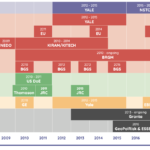Quantum Technology: the Next Supply Bottleneck?
By Nicole Horner, Alessandra Hool, and Min-Ha Lee
The rapid advancement of quantum technology holds the potential for significant societal benefits, including breakthroughs in healthcare and innovations to combat climate change—provided the technology is applied responsibly. It could, for instance, accelerate drug discovery by efficiently simulating molecular interactions or open up the gates to personalized medicine and real-time monitoring of patients’ health. Furthermore, quantum simulation or hybrid quantum computing have the potential to aid the design of batteries and clean energies. And these are only a select few of quantum technology’s many possible applications.
However, while the emergence of quantum technology presents a plethora of opportunities, it also brings to light challenges related to raw material supplies that are vital for its future physical deployment. Currently, the volumes of raw materials used in the sector seem largely insignificant when compared to annual global mining output. This is in part due to the technology operating at minuscule scales. But more significantly, it’s because quantum technology has yet to be mass-manufactured. With large-scale deployment of quantum technologies, this picture might change.
Examples of raw materials that are used in quantum technologies that could face potential supply chain risks include critical raw materials such as helium, molybdenum, and certain rare earth elements such as ytterbium and holmium. However, while it seems certain that quantum technology will be widely adopted in the future, the specific requirements for raw materials across its various applications remain unclear. Many different approaches and technologies are currently being explored and developed, and it’s yet to be determined which will prevail in the long term. This uncertainty means that we cannot accurately assess the potential risks of resource availability, as certain materials may be required in greater quantities than others.
The Netherlands Organisation for Applied Research (TNO) highlights that when examining the supply chain of quantum technology, it is less relevant to focus solely on raw materials. Instead, TNO points out that bottlenecks are more likely to occur during the processing stage, where semi-manufactured goods and isotopes are produced. It emphasizes that materials such as helium-3, an isotope of helium needed for the operation of dilution refrigerators used to achieve extremely low temperatures required for quantum computing, could be potential chokepoints for quantum technology deployment.
The Stanford Centre for Responsible Quantum Technology (RQT) has also recognised the need to discover potential vulnerabilities in critical raw materials supply chains, should quantum computers and sensors be adopted at scale. Dr. Min-Ha Lee, IRTC Founding Member, Fellow at Stanford University, and Principal Researcher at the Korea Institute of Industrial Technology, proposes the creation of a Quantum Criticality Index (QCI). This index would serve as a risk analysis tool to ensure the availability of resources needed for quantum technology to the United States for both economic and geopolitical purposes. To create the QCI, advanced analytical tools such as machine learning and artificial neural networks (ANNs) will be used to analyse a broad array of indicators related to CRM supply chains of quantum technologies.
Despite the relative novelty of quantum criticality, international and national policies regarding quantum technology supply chains are gradually increasing. The United States, for instance, recently re-authorized the Quantum Initiative Act, which includes the aim to secure the supply of critical resources of quantum technologies. The European Commission acknowledged the significance of quantum technology in October 2023, selecting it as one of four critical technology areas for the EU.
One of the significant issues highlighted in the discussion is the dependency on specific regions or countries for essential materials, components, and equipment. This concentration of essential materials increases the risk of disruptions in the supply chain, impacting the production and development of quantum technologies.
In its Quantum Economy Blueprint, the World Economic Forum (WEF) aims to advise regions and countries in developing their own framework surrounding quantum technology. It emphasizes the need for supply chain mapping to strengthen the quantum supply chain by creating an overview of components at various levels (raw materials, components, devices, control environment, and operational elements), categorizing them as specific or non-specific to quantum technologies, and analysing material availability.
The development of sustainable and diverse sourcing strategies and alternatives will be increasingly important in the near future to address potential shortages and ensure the successful implementation of quantum technologies. Nation-states might consider fostering collaboration and investments between public and private sectors in quantum-related industries. By aligning interests and resources, the goal is to bolster the resilience of the supply chain and reduce risks associated with material dependencies for quantum technology advancements.
Sources
Quantum Initiative Act Reauthorization. Senate and House of Representatives of the United States of America. July 2024. https://www.congress.gov/bill/118th-congress/house-bill/6213
“Quantum Criticality Index”. Stanford Center for Responsible Quantum Technology. https://law.stanford.edu/stanford-center-for-responsible-quantum-technology/projects/quantum-criticality-index/#:~:text=However%2C%20these%20advancements%20assume%2C%20as,germanium%2C%20lithium%2C%20and%20cobalt
Critical Raw Materials for Quantum Technologies – Towards European sovereignty in an emerging industry. Quantum Delta NL. November 2023. https://www.tno.nl/publish/pages/4049/white-paper-crms-for-qt.pdf
The Quantum-Medical Nexus: Understanding the Impact of Quantum Technologies on Healthcare. PubMed Central. October 2023. https://www.ncbi.nlm.nih.gov/pmc/articles/PMC10689891/
Quantum Economy Blueprint. World Economic Forum. January 2024. https://www3.weforum.org/docs/WEF_Quantum_Economy_Blueprint_2024.pdf
A call for responsible quantum technology. Nature Physics. April 2024. https://www.nature.com/articles/s41567-024-02462-8
New Materials Will Bring the Next Generation of Quantum Computers. Wired. December 2022. https://www.wired.com/story/materials-computing-science/
European Declaration on Quantum Technologies. European Commission. December 2023. https://digital-strategy.ec.europa.eu/en/library/european-declaration-quantum-technologies
“A Framework for Assessing Vulnerabilities in the Quantum Computing Materials Supply Chain“, Min-Ha Lee, Stanford University, October (2023)
“Quantum materials: a criticality perspective“, UK-US Critical Minerals R&D Workshop, Chicago, March (2024)
Image: iStock (bpawesome)




